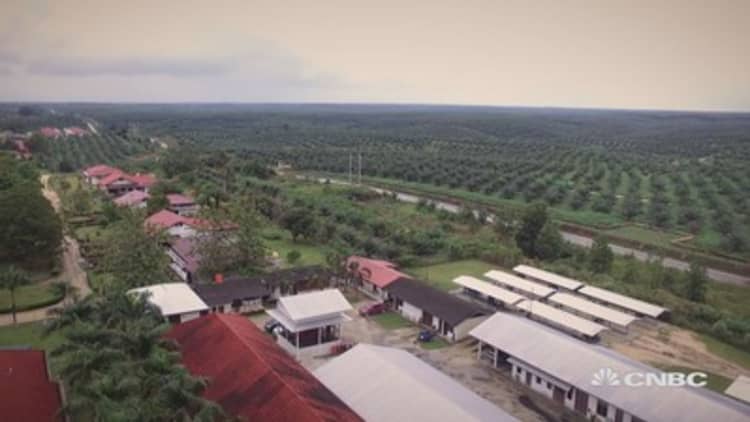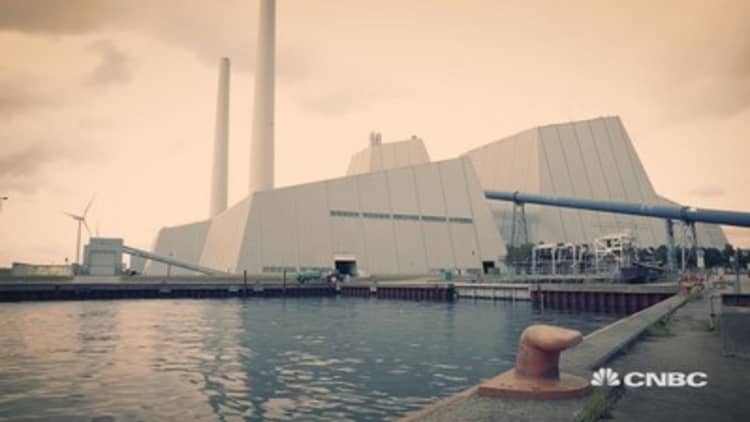For hundreds of millennia, humans have depended on wood as a basic but reliable source of fuel. Today efforts to grow that dependence in the face of an evolving energy landscape are widespread. But they're also contentious.
The debate over biomass, an umbrella term that encompasses a range of organic materials used for energy, rests primarily on the question of "carbon neutrality." It's taking place at the federal level — the House Appropriations Committee voted during the summer to designate biomass "carbon neutral" — and across the states.
Massachusetts Gov. Charlie Baker announced in August that his administration would move to designate fuel derived from felling trees and clearing brush in forests as renewable energy. In Arizona the state's Public Service recently ordered to research forest bioenergy as part of its power portfolio. The biomass industry's main trade group is part of a just-hatched PR and advertising blitz planned for later in September by an umbrella renewable-energy consortium that also includes wind and solar and has dubbed itself National Clean Energy Week.
A small, 1,000-kilowatt-hour wood-pellet power plant — generally enough to power 1,000 homes — produces a total of 1,275 grams of CO2 per kilowatt hour of electricity generated, according to Dr. Puneet Dwivedi, a research professor at the University of Georgia. In comparison, a 1,000-kilowatt-hour coal plant emits 1,048 grams of CO2 per kilowatt hour — 227 grams less than the biomass plant.
So when it comes to emissions, burning coal is technically more carbon-efficient than burning woody biomass. But forests have the ability to act as a "carbon sink," absorbing and storing the CO2 released from electricity generation. This lends credence to the claim that with appropriate forestry management, including the immediate replacement of trees that are cut down, biomass can be a "renewable" and a carbon-neutral source of energy.
The industry also claims that there would be no market for leftover logging residues if they were not used for biomass. When left on the forest floor, these organic scraps decay and emit methane, a greenhouse gas roughly 30 times more potent than CO2. On its website the Biomass Power Association states that "biomass power generates carbon-neutral electricity from natural organic waste, providing sustainable energy." It does not qualify this claim with the aforementioned details about appropriate forestry management.
Today these nuances have rendered woody biomass an oddity in the realm of polarized debate about non-fossil-fuel sources of energy.
The business of biomass
During the summer, the House Appropriations Committee voted to approve a $31.4 billion spending bill for the EPA, the Interior Department and other related agencies. Among the many policy riders incorporated in the bill was a provision requiring the EPA to "reflect the carbon-neutrality of forest bioenergy and recognize biomass as a renewable-energy source."
A second provision called for EPA policies that would "encourage private investment throughout the forest biomass supply chain," including the manufacturing of wood and paper products. The U.S. forest and paper industry is by far the world's largest, generating annual sales of $240 billion and accounting for 8 percent of total U.S. manufacturing output, according to the Center for Invasive Species and Ecosystem Health. The industry is heavily centered in the 13 southern states, where forests are so productive that they produce 19 percent of the world's pulp and paper products, despite only composing 2 percent of the globe's total forest.
Today the market for biomass wood pellets is a global one. In Europe, for example, demand for wood pellets has skyrocketed to 19 million metric tons per year, as the EU — which supports the carbon-neutrality claim in its current clean energy package — attempts to move away from dependence on fossil fuels. In 2016 the United Kingdom and Belgium purchased a combined 4.5 million metric tons from the United States, or 96.6 percent of the country's total wood-pellet exports.

Demand exists on a local level, too, says Carrie Annand, executive director of the Biomass Power Association. The BPA represents 80 stand-alone biomass power plants across the country, including plants run by Weyerhaeuser's Plum Creek Timber, France-based utility EDF Renewable Energy, and Lockheed Martin, which through its Energy division, is involved in multiple, novel generation technologies, including biomass and ocean wave energy. Most of the biomass plants, usually located in rural areas with an existing farming or forestry industry, purchase the organic waste leftover from nearby operations, which Annand claims would otherwise be "left on the forest floor, burned in a flash pile or become fodder for a forest fire down the line."
"Our members are infusing money into the local economy by buying these wastes that really don't have another use," Annand said. "In some areas out west, the forest service sees biomass power as an important outlet for dead and dying fibers."
Any kind of demand for wood products is enormously helpful to the forestry industry, said Dr. Dwivedi, whose home state of Georgia supports more than 115,000 forestry jobs. Bioenergy markets promote active forest management, which helps not only in providing employment opportunities, but also in improving environmental accountability and reducing chances of deforestation.
As of today, biomass remains a blip on the U.S. electricity grid. The sweeping report just issued by the Department of Energy about electricity markets and grid reliability had only this to say about biomass:
"Geothermal, biomass and combined heat and power plants are often operated as baseload plants, operating at a relatively stable level over a long period of time. However, because these types of plants are not as prevalent or widespread as gas, coal, and nuclear plants, this study did not perform detailed analyses of trends and closures for these technologies."
Legislating science
The 2018 House Appropriations bill is not the first time Congress has attempted to make a ruling on the carbon neutrality of biomass. Last year's bill, which was ultimately passed by the Senate, included similar language. The Senate also passed an amendment to the Energy Policy Modernization Act that established the same goals for the use of forest biomass as an energy solution.
In response, 65 research scientists and practitioners sent an open letter to the Senate decrying the legislation, which, while "well intentioned," they claimed would make climate change much worse.
"Mandating that there are no carbon dioxide emissions from burning wood from forests to produce energy does not make it so in fact," the letter stated.
"Lord knows what the Appropriations Committee is doing weighing in on this issue," said William Schlesinger, one of the 65 scientists and the retired president of the Cary Institute of Ecosystem Studies. "I think it would be much more reasonable for the Natural Resources Committee to be the one considering this."

The Appropriations Committee bill has not gone to the full House for a vote, and with a packed legislative agenda this fall, including the fiscal cliff, tax reform, disaster relief and immigration, it's not clear how much attention this issue will receive.
"Obviously, Congress has a very challenging schedule this fall and for the rest of the year. The biomass provision is one that has considerable support on both sides of the aisle, so I'm optimistic that it will pass when it's taken up, although it's unclear when that will be," Annand said.
It's never a good idea to legislate scientific fact, Schlesinger said. The carbon neutrality of biomass is a science that is far more nuanced than its face value suggests.
In 2011 the EPA embarked on a mission to develop a framework for accounting biogenic CO2 emissions, a mission that was expected to take three years. As of today, six years later, the framework has still not been finalized. It has undergone multiple revisions and is still being reviewed by the EPA's Science Advisory Board.
Madhu Khanna, a research professor at the University of Illinois, currently sits on the Science Advisory Board. Along with Puneet Dwivedi, she was contracted by the Biomass Power Association to study the carbon intensity of biomass electricity. The scenario they analyzed found that, with appropriate forest management and site rotation, the annual growth of trees would offset emissions and result in carbon savings of 115 percent lower than natural gas-based electricity in the first year of operation and 98 percent lower over 100 years. Their report was released in May.
But varying scenarios produce varying results, and carbon neutrality can't be used as a blanket assumption, Dwivedi said.
"The notion that this is a binary question is part of the problem," said Steve Hamburg, the chief scientist of the Environmental Defense Fund, adding, "I tend to call it a Goldilocks problem." He explained: "The claim that biomass is carbon neutral is a true statement. But it's not true if you don't use a several-hundred-year timeline. And so it becomes an issue of time: Over what time period are you trying to have a minimal climate impact?"
Common forestry practice involves replanting trees after they're cut down, which is how biomass earned its "renewable" label. And though these new trees will eventually sequester the CO2 released from burning biomass, this a debt that won't be repaid until they reach maturity. Given that the issue of irreversible climate change is predicted by most models to play out over the next 40 or 50 years, many scientists like Schlesinger and Hamburg believe this is too long of a payback period to treat biomass as carbon-neutral.
There are types of bioenergy that can have a minimal climate impact over a 10-year period, according to Hamburg, but it depends on what kind of materials and how they're used. Using residues and employing harvest rotation, for example, could drive a sustainable and carbon neutral operation like the one detailed by Dwivedi and Khanna.
But not all bioenergy is produced that way, and Hamburg said the congressional process is not a good vehicle to differentiate between sources that will create a net climate benefit and those that will create net damage.
— Zachary Basu, special to CNBC.com

